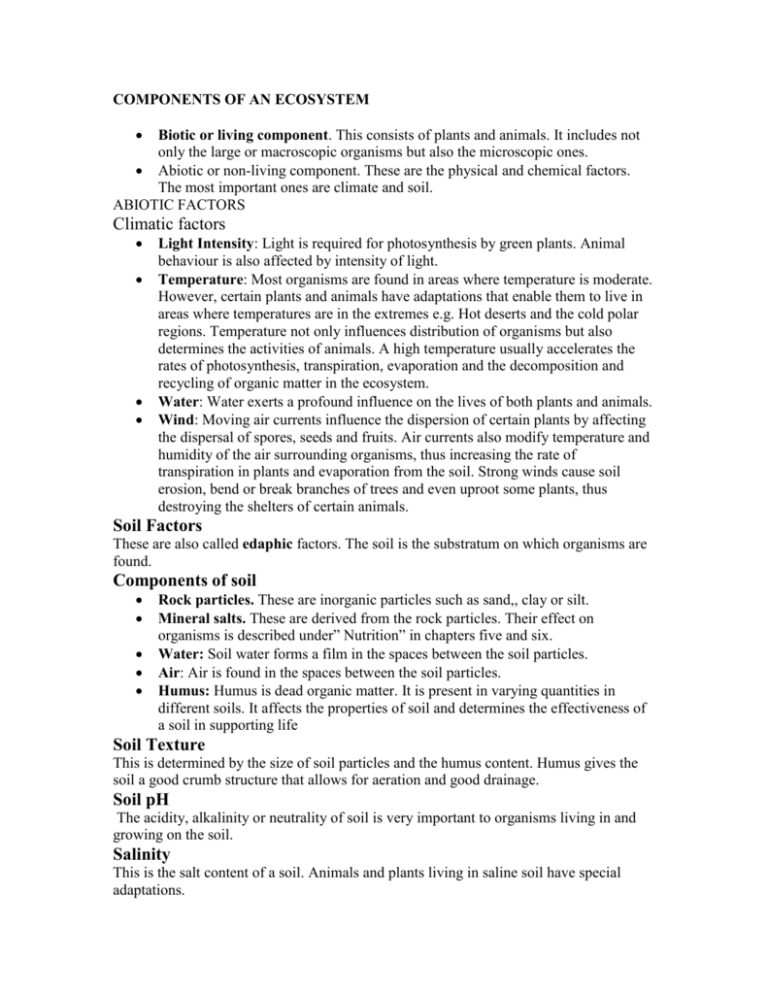1335519687
advertisement

COMPONENTS OF AN ECOSYSTEM Biotic or living component. This consists of plants and animals. It includes not only the large or macroscopic organisms but also the microscopic ones. Abiotic or non-living component. These are the physical and chemical factors. The most important ones are climate and soil. ABIOTIC FACTORS Climatic factors Light Intensity: Light is required for photosynthesis by green plants. Animal behaviour is also affected by intensity of light. Temperature: Most organisms are found in areas where temperature is moderate. However, certain plants and animals have adaptations that enable them to live in areas where temperatures are in the extremes e.g. Hot deserts and the cold polar regions. Temperature not only influences distribution of organisms but also determines the activities of animals. A high temperature usually accelerates the rates of photosynthesis, transpiration, evaporation and the decomposition and recycling of organic matter in the ecosystem. Water: Water exerts a profound influence on the lives of both plants and animals. Wind: Moving air currents influence the dispersion of certain plants by affecting the dispersal of spores, seeds and fruits. Air currents also modify temperature and humidity of the air surrounding organisms, thus increasing the rate of transpiration in plants and evaporation from the soil. Strong winds cause soil erosion, bend or break branches of trees and even uproot some plants, thus destroying the shelters of certain animals. Soil Factors These are also called edaphic factors. The soil is the substratum on which organisms are found. Components of soil Rock particles. These are inorganic particles such as sand,, clay or silt. Mineral salts. These are derived from the rock particles. Their effect on organisms is described under” Nutrition” in chapters five and six. Water: Soil water forms a film in the spaces between the soil particles. Air: Air is found in the spaces between the soil particles. Humus: Humus is dead organic matter. It is present in varying quantities in different soils. It affects the properties of soil and determines the effectiveness of a soil in supporting life Soil Texture This is determined by the size of soil particles and the humus content. Humus gives the soil a good crumb structure that allows for aeration and good drainage. Soil pH The acidity, alkalinity or neutrality of soil is very important to organisms living in and growing on the soil. Salinity This is the salt content of a soil. Animals and plants living in saline soil have special adaptations. Topography It is important to survey the area chosen for an ecological study before beginning the actual study in order to be properly aquainted with the topography or surface features. The factors considered are mainly gradient, altitude, depression and moulds. All these characteristics affect the distribution of organisms in an area. THE BIOTIC COMPONENT This refers to the living organisms in an ecosystem. Trophic levels: Organisms in a particular habitat have different feeding levels. These are referred to as trophic levels. There are two main trophic levels. 1. Producers: Organisms that occupy the first trophic level are known as producers. These are the organisms that manufacture their own food (autotrophs). 2. Consumers: These are the organisms that feed on organic matter manufactured by green plants. They occupy different trophic levels as follows: (a) Herbivores (Primary consumers): These are the animals that feed on green plants. (b) Carnivores (Secondary consumers): These are animals that feed on flesh. First order carnivores feed on herbivores while second order feed on other carnivores and so on. (c) Omnivores: These are animals that feed on both plant and animal material. (d) Detritivores: Detritivores feed on organic wastes and dead matter derived from the grazing food chain. Many different type of organisms feed on detritus. They include fungi, protozoa, insects, mites, annelids and nematodes. (e) Decomposers: These organisms feed on dead organic matter thereby causing decomposition and decay and releasing nutrients for plants. They form a link between the biotic and the abiotic components. Food Chains A food chain is a linear relationship between producers and consumers. It represents the transfer of food energy from green plants through repeated stages of eating and being eaten. Types of Food Chains Grazing food chain starts with green plants. Detitius food chain detritus) starts with dead organic matter( debris or





